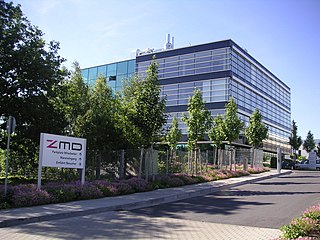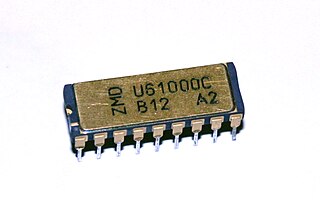
East Germany had a command economy, similar to the economic system in the Soviet Union and other Comecon member states — in contrast to the market economies or mixed economies or other capitalist states. The state established production targets, set prices, and also allocated resources, codifying these decisions in comprehensive plans. The means of production were almost entirely state-owned.
The VEB Deutsche Schallplatten was the monopolistic music publisher in the German Democratic Republic from the 1950s until the 1980s.

Zentrum Mikroelektronik Dresden (ZMD) was regarded as the heart of East Germany's microelectronics research in the 1980s as well as its most advanced integrated circuit manufacturer. Together with TU Dresden and VEB Spurenmetalle Freiberg, ZMD formed the foundation for Silicon Saxony, a cluster of microelectronics companies that came to include new fabs by Siemens and AMD.
The Volkseigenes Gut was a state-owned farm in the German Democratic Republic (GDR), corresponding to the Soviet Sovkhoz and the Państwowe Gospodarstwo Rolne in the People's Republic of Poland. In contrast to the Landwirtschaftliche Produktionsgenossenschaft (LPG) or collective farm, another form of state agricultural enterprise, the VEGs were often the successors to former private farms which resulted from the land reform in the Soviet sector of Germany mandated in the Potsdam Agreement of 1945.

The DR Class 243 is a universal electric locomotive of the Deutsche Reichsbahn which is used for general rail service. Deutsche Bahn lists the locomotive as Class 143. The locomotives of class 143/243 still belong to the most successful class of German electric locomotives.

Sternburg is a brand of German beer, brewed and bottled by Radeberger Group. Their best selling product is "Sternburg Export". In 2006 it had 9.5% of the market share in Eastern Germany.
VEB Typoart was the only type foundry of East Germany. It was a state-owned enterprise located in Dresden. The foundry's most influential art directors were Herbert Thannhäuser and Albert Kapr.

The football league system of the German Democratic Republic existed from 1949 until shortly after German reunification in 1991.

The DR Class 65.10 was a four-coupled passenger train tank engine operated by the East German Deutsche Reichsbahn (DR) for heavy suburban and commuter services.
Buna Werke Schkopau were a chemical company specialising in the production of polymer materials such as plastics and artificial rubber. The name BUNA is derived from the technology of polymerising butadiene with sodium as a catalyst.

Deutscher Verlag der Wissenschaften (DVW) was a scientific publishing house in the former German Democratic Republic.

The Elektro-Apparate-Werke (EAW) was a state-owned industrial operation of the German Democratic Republic. It was a successor of the combine VEB Elektro-Apparate-Werke (VEB) and, with more than 8000 employees, was one of the largest manufacturers of electrical appliances in the DDR.

VEB Kombinat Mikroelektronik Erfurt was an important manufacturer of active electronic components in East Germany. It should not be confused with the more well-known VEB Kombinat Robotron Dresden which used integrated circuits from Kombinat Mikroelektronik in its computers.

East Germany was one of the leading computer producers in the Eastern Bloc as purchases of higher technologies from the West were under various embargoes. A program of illegal purchases, copying and reverse engineering of Western examples was established, after which GDR sold these computers to COMECON countries. Under the rule of Erich Honecker, electronics, microelectronics and data processing industries grew at average 11.4% in the 1970s and 12.9% during the 1980s.

S-Bahn Erfurt was a colloquial term for a diesel-powered railway connection that existed from 1976 to 1995 in the Thuringian state capital Erfurt, Germany. The term "S-Bahn" is also occasionally used in popular literature. Other contemporary media used terms such as "suburban traffic at the local transport tariff" to describe it. When the line was introduced in 1976, only the "reversible train service" on this line was highlighted as a special feature. In the Kursbuch tables of Deutsche Reichsbahn, the terms "S-Bahn" or "S-Bahn-Tarif" were not used for this line. Riethschleuder was another colloquial term for the connection.
The UC compander system is a noise reduction system for vinyl records, aiming at highest playback compatibility even without corresponding UC expander.

The Trabant P 50, also known as the Trabant 500, is the first series production model of the East German Trabant series, made by VEB Sachsenring Automobilwerke Zwickau. It was produced from 1957 until 1962; in total, 131,495 units were built. In 1962, VEB Sachsenring switched production from the P 50 to the short-lived intermediate model Trabant 600, which combined the exterior styling of the Trabant P 50 with the technical design of the next generation Trabant model, the Trabant 601.
The Fachbuchverlag Leipzig was an East German publisher. It continues to exist as an imprint of the Munich publishing firm Carl Hanser Verlag.
Verlag Technik based in Berlin today is the remaining part of its incorporation into the Huss-Medien GmbH.













